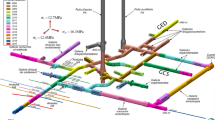Abstract
The main purpose of this paper is to analyze the convergence measurements in drifts of the Underground Research Laboratory (URL) of the French National Radioactive Waste Management Agency (Andra), excavated in Callovo-Oxfordian claystone. These measurements show an anisotropic closure, which depends on the drift orientations with respect to the horizontal in situ stresses. This anisotropic character of the deformation is taken into account by assuming that the drifts section evolves following an elliptical shape. The characteristics of the deformed elliptical section are evaluated following the methodology proposed by Vu et al. (Rock Mech Rock Eng 46:231–246, 2013). Then, using the semi-empirical law proposed by Sulem et al. (Int J Rock Mech Min Sci Geomech Abstr 24:145–154, 1987), the convergence evolution is fitted independently for each axis of the ellipse. This method allows to distinguish two effects: the face advance and the time-dependent behavior of the ground. The results for the two drift orientations (along the major horizontal stress and perpendicular to it) show very close values for the parameters describing the time-dependent properties of the ground, the distance of influence of the face, and the extent of the decompressed zone around the drift. Finally, the model is validated by keeping these parameters as constants and by simulating the convergence data on a new drift. It is shown that with a period of about 40 days of convergence monitoring, the model can provide valuable insights for predictions of the convergence evolution in the long term.


















Similar content being viewed by others

References
Armand G, Noiret A, Cruchaudet M, Conil N (2011) Mine by experiment performed in the Callovo-Oxfordian Claystone at the Meuse Haute Marne underground research laboratory (France). In: Qian Q, Zhou Y (eds) Harmonising Rock Engineering and the Environment, Proceedings of the 12th ISRM Congress, Beijing, Oct 2011, pp 157–162
Armand G, Noiret A, Zghondi J, Seyedi DM (2013) Short- and long-term behaviors of drifts in the Callovo-Oxfordian claystone at the Meuse/Haute-Marne Underground Research Laboratory. J Rock Mech Geotech Eng 5:221–230
Armand G, Leveau F, Nussbaum C, de La Vaissiere R, Noiret A, Jaeggi D, Landrein P, Righini C (2014) Geometry and properties of the excavation induced fractures at the Meuse/Haute-Marne URL drifts. Rock Mech Rock Eng 47(1):21–41. doi:10.1007/s00603-012-0339-6
Blanco Martín L, Hadj-Hassen F, Tijani M, Armand G (2011) New numerical modelling of the mechanical long-term behaviour of the GMR gallery in ANDRA’s Underground Research Laboratory. J Phys Chem Earth 36(17–18):1872–1877. doi:10.1016/j.pce.2011.07.027
Blümling P, Bernier F, Lebon P, Derek Martin C (2007) The excavation damaged zone in clay formations time-dependent behaviour and influence on performance assessment. J Phys Chem Earth 32(8–14):588–599. doi:10.1016/j.pce.2006.04.034
Bonnet-Eymard T, Thiriat F, Piedevache M, Prouvot J, Richard-Panot L, Armand G, Laviguerie R, Martin F (2011) Soutènement souple pour le creusement de galeries dans les argilites du CMHM. In: Proceedings of the International Congress, AFTES, Underground spaces for tomorrow, Lyon, Oct 2011, pp 1–7
Delaloye D, Diederichs MS, Walton G, Hutchinson J (2015) Sensitivity testing of the newly developed elliptical fitting method for the measurement of convergence in tunnels and shafts. Rock Mech Rock Eng 48(2):651–667. doi:10.1007/s00603-014-0566-0
Delay J, Vinsot A, Krieguer JM, Rebours H, Armand G (2007) Making of the underground scientific experimental programme at the Meuse/Haute-Marne underground research laboratory, North Eastern France. J Phys Chem Earth 32(1–7):2–18. doi:10.1016/j.pce.2006.04.033
Martin F, Laviguerie R, Armand G (2010) Geotechnical feedback of the new galleries excavation at the ANDRA underground research laboratory, Bure (France). In: Zhao J, Labiouse V, Dudt JP, Mathier Jf (eds) Rock Mechanics in Civil and Environmental Engineering, Proceedings of Eurock, Lausanne, June 2010, pp 779–782
Noiret A, Armand G, Cruchaudet M, Conil N (2011) Mine-by experiments in order to study the hydromechanical behavior of the Callovo-Oxfordian claystone at the Meuse Haute-Marne underground research laboratory (France). In: Proceedings of the 8th international symposium on field measurements in geomechanics, FMGM, Berlin, Sep 2011, pp 12–16
Panet M (1996) Two case histories of tunnels through squeezing rocks. Rock Mech Rock Eng 29(3):155–164. doi:10.1007/BF01032652
Pardoen B, Levasseur S, Collin F (2014) Using local second gradient model and shear strain localisation to model the excavation damaged zone in unsaturated Claystone. Rock Mech Rock Eng. doi:10.1007/s00603-014-0580-2
Plassart R, Fernandes R, Giraud A, Hoxha D, Laigle F (2013) Hydromechanical modelling of an excavation in an underground research laboratory with an elastoviscoplastic behaviour law and regularization by second gradient of dilation. Int J Rock Mech Min Sci 58:23–33. doi:10.1016/j.ijrmms.2012.08.011
Schubert W (2008) The development of the observational method. Geomech Tunnelling 1(5):352–357. doi:10.1002/geot.200800035
Souley M, Armand G, Su K, Ghoreychi M (2011) Modeling the viscoplastic and damage behavior in deep argillaceous rocks. J Phys Chem Earth 36(17–18):1949–1959. doi:10.1016/j.pce.2011.10.012
Steiner PR (2007) Displacement measurements ahead of a tunnel face using the RH Extensometer. In: Proceedings of the 7th international symposium on field measurements in geomechanics, FMGM, Boston, Sep 2007, pp 1–8
Sulem J, Panet M, Guenot A (1987) Closure analysis in deep tunnels. Int J Rock Mech Min Sci Geomech Abstr 24(3):145–154. doi:10.1016/0148-9062(87)90522-5
Vu TM (2010) Comportement des tunnels en terrains tectonisés—application à la liaison ferroviaire Lyon-Turin. PhD Thesis, Université Paris-Est, France
Vu TM, Sulem J, Subrin D, Monin N, Lascols J (2013) Anisotropic closure in squeezing rocks: the example of Saint-Martin-la-Porte access gallery. Rock Mech Rock Eng 46:231–246. doi:10.1007/s00603-012-0320-4
Wileveau Y, Cornet FH, Desroches J, Blumling P (2007) Complete in situ stress determination in an argillite sedimentary formation. J Phys Chem Earth 32(8–14):866–878. doi:10.1016/j.pce.2006.03.018
Author information
Authors and Affiliations
Corresponding author
Rights and permissions
About this article
Cite this article
Guayacán-Carrillo, LM., Sulem, J., Seyedi, D.M. et al. Analysis of Long-Term Anisotropic Convergence in Drifts Excavated in Callovo-Oxfordian Claystone. Rock Mech Rock Eng 49, 97–114 (2016). https://doi.org/10.1007/s00603-015-0737-7
Received:
Accepted:
Published:
Issue Date:
DOI: https://doi.org/10.1007/s00603-015-0737-7



